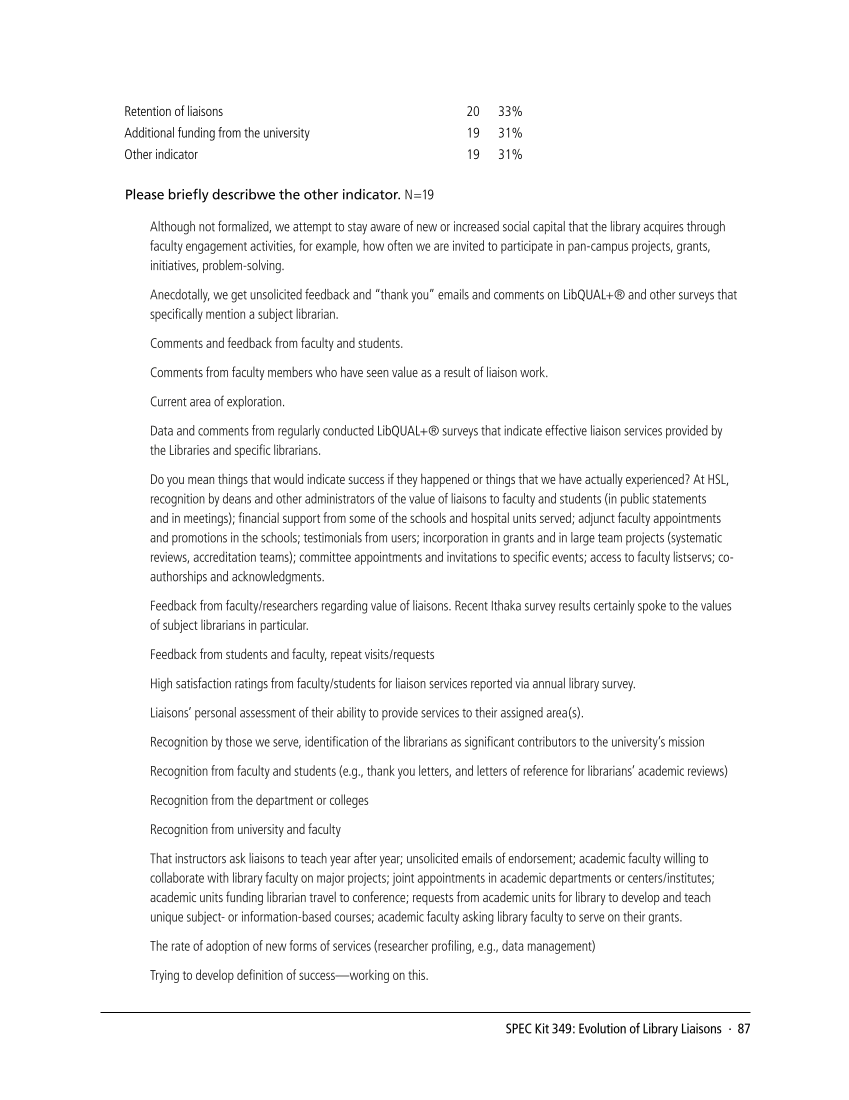SPEC Kit 349: Evolution of Library Liaisons · 87
Retention of liaisons 20 33%
Additional funding from the university 19 31%
Other indicator 19 31%
Please briefly describwe the other indicator. N=19
Although not formalized, we attempt to stay aware of new or increased social capital that the library acquires through
faculty engagement activities, for example, how often we are invited to participate in pan-campus projects, grants,
initiatives, problem-solving.
Anecdotally, we get unsolicited feedback and “thank you” emails and comments on LibQUAL+® and other surveys that
specifically mention a subject librarian.
Comments and feedback from faculty and students.
Comments from faculty members who have seen value as a result of liaison work.
Current area of exploration.
Data and comments from regularly conducted LibQUAL+® surveys that indicate effective liaison services provided by
the Libraries and specific librarians.
Do you mean things that would indicate success if they happened or things that we have actually experienced? At HSL,
recognition by deans and other administrators of the value of liaisons to faculty and students (in public statements
and in meetings) financial support from some of the schools and hospital units served adjunct faculty appointments
and promotions in the schools testimonials from users incorporation in grants and in large team projects (systematic
reviews, accreditation teams) committee appointments and invitations to specific events access to faculty listservs co-
authorships and acknowledgments.
Feedback from faculty/researchers regarding value of liaisons. Recent Ithaka survey results certainly spoke to the values
of subject librarians in particular.
Feedback from students and faculty, repeat visits/requests
High satisfaction ratings from faculty/students for liaison services reported via annual library survey.
Liaisons’ personal assessment of their ability to provide services to their assigned area(s).
Recognition by those we serve, identification of the librarians as significant contributors to the university’s mission
Recognition from faculty and students (e.g., thank you letters, and letters of reference for librarians’ academic reviews)
Recognition from the department or colleges
Recognition from university and faculty
That instructors ask liaisons to teach year after year unsolicited emails of endorsement academic faculty willing to
collaborate with library faculty on major projects joint appointments in academic departments or centers/institutes
academic units funding librarian travel to conference requests from academic units for library to develop and teach
unique subject- or information-based courses academic faculty asking library faculty to serve on their grants.
The rate of adoption of new forms of services (researcher profiling, e.g., data management)
Trying to develop definition of success—working on this.
Retention of liaisons 20 33%
Additional funding from the university 19 31%
Other indicator 19 31%
Please briefly describwe the other indicator. N=19
Although not formalized, we attempt to stay aware of new or increased social capital that the library acquires through
faculty engagement activities, for example, how often we are invited to participate in pan-campus projects, grants,
initiatives, problem-solving.
Anecdotally, we get unsolicited feedback and “thank you” emails and comments on LibQUAL+® and other surveys that
specifically mention a subject librarian.
Comments and feedback from faculty and students.
Comments from faculty members who have seen value as a result of liaison work.
Current area of exploration.
Data and comments from regularly conducted LibQUAL+® surveys that indicate effective liaison services provided by
the Libraries and specific librarians.
Do you mean things that would indicate success if they happened or things that we have actually experienced? At HSL,
recognition by deans and other administrators of the value of liaisons to faculty and students (in public statements
and in meetings) financial support from some of the schools and hospital units served adjunct faculty appointments
and promotions in the schools testimonials from users incorporation in grants and in large team projects (systematic
reviews, accreditation teams) committee appointments and invitations to specific events access to faculty listservs co-
authorships and acknowledgments.
Feedback from faculty/researchers regarding value of liaisons. Recent Ithaka survey results certainly spoke to the values
of subject librarians in particular.
Feedback from students and faculty, repeat visits/requests
High satisfaction ratings from faculty/students for liaison services reported via annual library survey.
Liaisons’ personal assessment of their ability to provide services to their assigned area(s).
Recognition by those we serve, identification of the librarians as significant contributors to the university’s mission
Recognition from faculty and students (e.g., thank you letters, and letters of reference for librarians’ academic reviews)
Recognition from the department or colleges
Recognition from university and faculty
That instructors ask liaisons to teach year after year unsolicited emails of endorsement academic faculty willing to
collaborate with library faculty on major projects joint appointments in academic departments or centers/institutes
academic units funding librarian travel to conference requests from academic units for library to develop and teach
unique subject- or information-based courses academic faculty asking library faculty to serve on their grants.
The rate of adoption of new forms of services (researcher profiling, e.g., data management)
Trying to develop definition of success—working on this.












































































































































































































